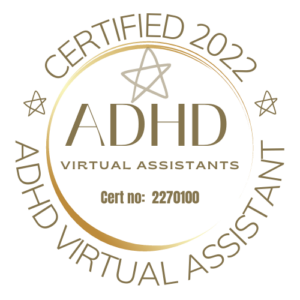Recently I was talking to my husband and casually mentioned the term “masking” in relation to ADHD. First I received a puzzled look, and then he asked me, “What does masking mean?” As I struggled to articulate what exactly it meant in relation to ADHD, it occurred to me that while it’s a term I understand in theory, I needed to learn more. I decided to spend some time understanding it better myself, and it struck me just how deeply this can actually affect those of us with ADHD.
What Does ADHD Masking Even Mean?
ADHD masking is when someone with ADHD presents themselves in a way that seems like they are not living with the “disorder” (if you’ve followed me for any length of time, you know I strongly dislike that term – which is why I place it quotes). It’s also called “impression management”, which was a new term for me. The term was coined by psychologist Russell Barkley, who said it occurs in about one-third of all people with ADHD – which I found to be painful to read.
ADHD masking may also be called “camouflaging.” This is when someone with ADHD tries to cover up their symptoms by copying the behaviors of people who don’t have it. ADHD masking and/or camouflaging can be a way for some people with ADHD to fit in socially, avoid being stigmatized, or feel more accepted.
Types of ADHD masking include hiding hyperactivity with calmness we don’t feel, sitting quietly without squirming in one’s seat while wanting to jump out of our skin, or responding as you are expected to – even though your mind may feel chaotic. Masking may also include over-focusing on a person, task, or activity to avoid distractions and impulsivity.
While some of these things may not seem to be bad on the surface, when they’re in direct contradiction to how we actually feel or who we truly are, they have the potential to be damaging.
ADHD Masking’s Prevalence
Russell Barkley also wrote about the ADHD masking phenomenon in his (well worth reading) book, “Taking Charge of Adult ADHD.” He said that some people with ADHD try to show others that they have it under control by controlling their symptoms. In essence, we’re trying to conform to the expectations of the neuro-typical world around us.
Research on ADHD masking is still limited, unfortunately somewhat subjective, and it has not been studied extensively. Russell Barkley said that this is due to the fact that ADHD masking is a very difficult concept for people without ADHD to understand, so they may find it hard to believe. In truth though, even neuro-typical individuals do this to an extent, and often unconsciously.
What’s more, people with ADHD may be ashamed to admit they are “faking” it, and doctors don’t always ask patients about this possibility. So, in actuality, it may be that ADHD masking is even more common than we know.
What Does ADHD Masking Look Like?
ADHD masking is a way of hiding symptoms from others. We do this through learned and observed behaviors that can be healthy or unhealthy. Many of us with ADHD break social “rules” through our behaviors and may face shame and/or ridicule. As a result, we develop coping strategies to hide parts of ourselves – which then can have an increasingly negative impact on us internally.
It can be used as a coping mechanism and is sometimes developed when people are young and trying to make sense of the world around them. Eventually, this behavior becomes difficult to manage on its own.
Below are some examples of ADHD masking. You’ll notice the words like “too”, “overly”, and “excessively”, which is why these can be issues for us.
- Staying too quiet and being overly careful about what we say to avoid talking too much, saying the wrong thing, or interrupting people.
- Obsessively checking our belongings to make sure that we don’t lose things.
- Reacting as we’re expected to during class or in a meeting instead of how we actually feel inside.
- Seeming “fine” and not showing any signs that there is a problem when in reality, we’re struggling to keep up or maintain relationships.
- Being overly conscientious about how clean the house looks, even though we may be overwhelmed by all the work it takes to keep it so.
- Hiding hyperactivity through calmness, so people think everything is fine. In reality, we have trouble focusing because our mind jumps from one thing to another too quickly, making it hard to process what anyone around us is saying at the moment.
- Being unable to relax leading up to appointments and arriving much too early as a way to ensure that we’re not late due to time blindness.
- Listening overly intently and focusing too hard when someone is talking, so as to not miss anything they say.
- Excessively writing everything down (endless lists) so we don’t forget it later due to memory issues with ADHD.
- Obsessively organizing paperwork and creating systems to make sure we can find what we need.
- Bottling up intense emotions until we feel sick inside without knowing why. This can sometimes also lead to depression and anxiety.
- Calling in sick or making excuses to avoid being placed in stressful or anxiety-inducing situations.
- Being irritable when we force ourselves to concentrate on something that doesn’t interest us for an extended period of time.
- Taking on too much responsibility to make up for what we perceive as our faults or flaws.
- Attempting to cope with the world by developing perfectionistic tendencies (e.g., expecting that we will never do anything wrong).
- Overdoing something until exhaustion sets in so that others see how capable and reliable we are, even though deep down we’re struggling.
- Hiding the fact that we may feel overwhelmed by our responsibilities, which leads to feelings of shame and guilt.
- A need to always appear in control to avoid feeling ashamed about whether others see our struggles.
- Suppressing stimming behaviors like leg bouncing so we don’t disturb others, even though we feel uncomfortable sitting still.
- Mimicking or copying other people in social situations so that we will be accepted
Impact of ADHD Masking On Lives
Masking creates its own set of problems. Behaving in ways that are not true to who we really are is only sustainable for so long before it impacts aspects of our lives. Below are some examples of the potential negative impacts of ADHD masking.
- Hiding symptoms, which may lead to a delay in diagnosis.
- Being unaware that they have undiagnosed ADHD, which can lead them to develop depression and anxiety.
- People may not believe you or take you seriously when you tell them that something is wrong or that you are struggling.
- Higher risk for developing substance abuse problems to cope with how they feel inside, which can obviously lead to even more issues down the line.
- Replacing outward stress with internal stress.
- Making it hard for us to know what is real and what is an act. We may feel as if we’re not able to be ourselves and instead turn into someone else so that others will like us.
Coping With ADHD Masking
When you can identify that ADHD masking is taking place, you can start learning ways to cope in the above situations without turning into someone else. You might be surprised at how much more enjoyable life becomes when you learn new skills for managing instead of hiding your struggles. Below are some ideas to get started.
- Identify which form of ADHD masking behaviors are healthy and which are hurting you. For example, learning to keep a reasonably clean home might be helpful, whereas needing everything to be perfect would be harmful. Perfection is ultimately unachievable for anyone, not just those of us with ADHD.
- Learn how to deal with your emotions instead of avoiding them. One way to do this is to seek out a therapist or coach who understands what you are going through. ADHD coaching has grown significantly in recent years, making it easier to find a coach who is a good fit for your individual needs and personality. A good coach or therapist will understand your struggles and provide you with strategies and methods to help.
- It’s also important to understand that you are not alone in how you experience life. Studies show that ADHD is much more common than many realized it to be. According to a study in the Journal of Global Health published by NIH National Library of Medicine, “By adjusting for the global demographic structure in 2020, the prevalence of persistent adult ADHD was 2.58% and that of symptomatic adult ADHD was 6.76%, translating to 139.84 million and 366.33 million affected adults in 2020 globally.” By connecting with other people going through the same struggles you are, it can help you feel less alone and isolated. For example, join a support group for people living with ADHD. Find an online or in-person community where it will be safe to express yourself without judgment. I have personally experienced a great deal of encouragement, growth, and increased understanding from being a part of such a group.
- Lastly, learn to delegate certain things to others. No one can do it all, regardless of having ADHD or not. By delegating the specific things that you can’t bring yourself to do, find yourself procrastinating endlessly on, or that cause you to experience a sense of failure, it not only allows those things to be completed, but it also removes some of the obstacles that can lead to a continual sense of inadequacy or shame.
In Conclusion
ADHD masking is a way of coping that feels easier in the moment, but it does nothing to help you deal with what truly needs attention inside yourself. In fact, it can be incredibly damaging in the long run. By understanding how to manage instead of mask, recognizing when your behavior becomes too much, and learning new tools for dealing with stress, it is possible for us to finally start living life more fully and authentically.
If you would like to learn more about the types of things you can delegate to someone like the virtual assistants at The Ambitious Assistant, check out our free guide here.











